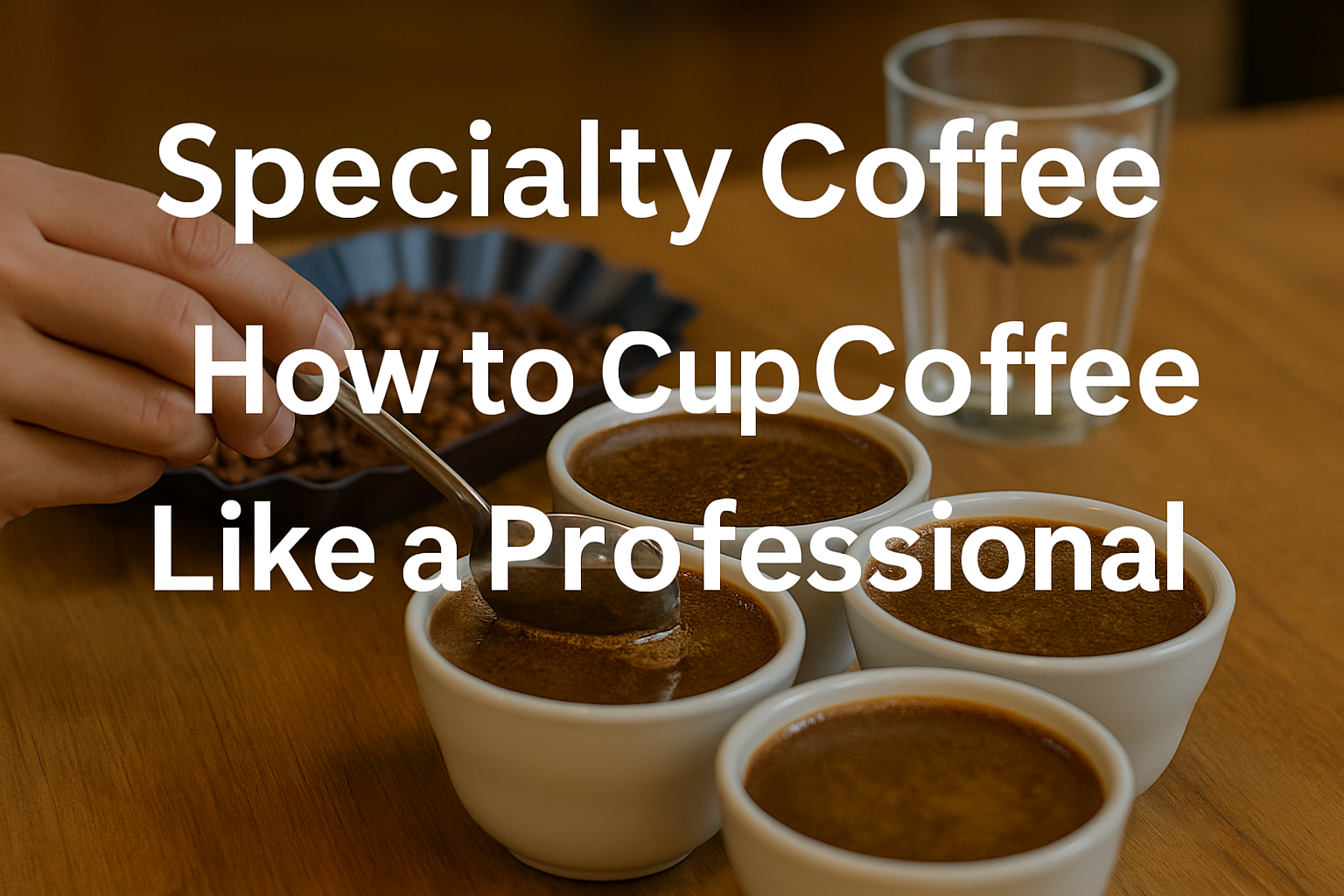In the world of specialty coffee, cupping is more than just a tasting ritual — it’s a structured method used by professionals to evaluate the quality, flavor, and characteristics of coffee beans.
Whether you’re a barista, roaster, or enthusiast, learning how to cup coffee like a pro helps you develop your palate, understand different origins, and make better decisions when selecting beans.
Cupping is the foundation of sensory evaluation in the coffee industry. It’s how farmers, buyers, and roasters communicate quality. For aspiring baristas, mastering cupping opens the door to deeper appreciation and expertise.
This guide will teach you what cupping is, why it matters, and how to do it step by step — the same way the pros do.
What Is Coffee Cupping?
Coffee cupping is a standardized tasting method that involves:
- Grinding coffee to a specific size
- Smelling the dry grounds
- Pouring hot water over the grounds in a cup
- Breaking the crust (floating grounds) and smelling the aroma
- Tasting the brewed coffee with a spoon while it’s hot and as it cools
It allows you to assess aroma, acidity, sweetness, body, balance, and aftertaste without being influenced by brew method or equipment.
Because cupping removes variables like filters, pressure, and devices, it helps tasters focus entirely on the bean itself.
Why Cupping Matters in Specialty Coffee
Cupping is essential for:
- Evaluating quality: Used by Q graders, buyers, and roasters to score coffee on a 100-point scale
- Choosing beans: Helps baristas or café managers compare options for their menus
- Training your palate: Teaches you how to identify subtle notes and differentiate coffees
- Communication: Gives you a shared language with producers and roasters
It’s not just about finding what tastes good — it’s about learning to describe what you taste and why.
What You’ll Need for a Cupping Session
Cupping doesn’t require expensive tools, but consistency is key. Here’s what you need:
- Fresh roasted whole bean coffee (2–4 different samples)
- Cupping bowls or wide glasses (150–200ml)
- Cupping spoons (or deep soup spoons)
- Coffee grinder
- Scale
- Filtered water heated to 93–96°C (200–205°F)
- Timer
- Notebook or cupping form
- Towel and water for rinsing spoons
If you’re working in a café, it’s worth investing in standard cupping gear. If you’re cupping at home, you can use glass bowls or small mugs.
Standard Cupping Ratio
Use a consistent coffee-to-water ratio. The industry standard is:
- 8.25g of coffee per 150ml of water
If you’re using larger cups, scale proportionally. Consistency ensures fair comparisons across coffees.
Step-by-Step: How to Cup Coffee
Follow these steps for a clean, repeatable cupping experience.
1. Grind the Coffee
Grind each sample medium-coarse, similar to French press. Use the same grind size for all coffees.
Place 8.25g of ground coffee into each cup. Smell the dry aroma and note your first impressions.
This is called fragrance — it gives you an early look at what’s to come.
2. Start the Timer and Add Water
Start your timer and pour 150ml of water over each sample, saturating all the grounds. The coffee will form a floating crust on the surface.
Don’t stir yet. Let the coffee steep undisturbed for 4 minutes.
3. Break the Crust
At 4:00, use a cupping spoon to gently break the crust of each cup. Push the floating layer back while bringing your nose close to inhale the aroma.
This is one of the most fragrant moments of the process — called wet aroma. Note the intensity and qualities (floral, fruity, spicy, etc.).
After breaking, scoop away the grounds from the surface with two spoons to keep the cup clean for tasting.
4. Taste the Coffee
Let the coffee cool slightly (to around 60–70°C), then start tasting.
- Use a cupping spoon
- Slurp the coffee quickly to spray it across your palate
- Taste each sample multiple times as it cools
As it cools, different flavors will emerge. Note acidity, sweetness, balance, mouthfeel, clarity, and aftertaste.
5. Compare and Take Notes
Use a cupping form or notebook to record what you experience. Common categories include:
- Fragrance (dry aroma)
- Aroma (wet aroma)
- Acidity (bright, sharp, mellow, juicy?)
- Sweetness (sugarcane, honey, caramel?)
- Body (light, medium, full?)
- Flavor (overall taste impression)
- Aftertaste (long, clean, bitter?)
- Balance (do the elements work well together?)
If you’re scoring coffees, each category can be rated 1 to 10 and added up to a final score. Coffees that score above 80 points are considered specialty grade.
Common Flavor Notes in Specialty Coffee
When cupping, try to use the Coffee Taster’s Flavor Wheel from the SCA. Here are some common descriptors you might encounter:
- Fruity: Berry, citrus, stone fruit, tropical
- Sweet: Caramel, honey, brown sugar
- Nutty: Almond, hazelnut
- Spicy: Cinnamon, clove, black pepper
- Floral: Jasmine, rose, hibiscus
- Savory: Tomato, olive, umami
- Chocolate: Cocoa, dark chocolate, milk chocolate
Don’t worry if you can’t identify flavors at first. With practice, your palate will become more sensitive.
Cupping Etiquette and Cleanliness
In professional environments, cleanliness is non-negotiable. Here are a few rules to follow:
- Use a clean spoon for each slurp or rinse between cups
- Avoid double-dipping
- Don’t talk while others are evaluating (until after the tasting)
- Label cups clearly
- Always cup blind (without knowing which coffee is which) for unbiased results
Respecting the cupping table creates a professional, focused environment for learning and evaluation.
How to Use Cupping as a Barista
Even if you’re not buying or roasting coffee, cupping helps you:
- Understand the nuances of different origins and roasts
- Choose the best beans for your brew methods
- Train your sensory memory
- Recommend coffees more confidently to customers
For example, if you cup a natural-processed Ethiopian coffee with blueberry notes, you’ll remember that flavor and know it pairs well with V60 or as a fruity espresso.
Use cupping results to build your flavor vocabulary and connect customers with coffees they’ll love.
Hosting Public Cuppings
Cuppings aren’t just for professionals — they’re a great way to engage your community and build customer loyalty.
To host a successful public cupping:
- Keep it casual and educational
- Use easy-to-understand language
- Walk guests through the steps
- Invite discussion without judgment
- Offer takeaway notes or cards
Make the experience interactive and welcoming. Customers love learning when the environment is relaxed.
Tips for Developing Your Palate
Cupping regularly is the best way to train your taste buds, but here are some extra tips:
- Taste a wide range of foods (fruits, herbs, spices)
- Smell everything — build your aroma library
- Cup coffees side-by-side (same origin, different processes)
- Practice blind tastings
- Compare notes with others
Your palate is like a muscle — the more you use it, the stronger it gets.
Final Thoughts: Cupping Is the Barista’s Superpower
Learning to cup coffee like a professional isn’t just about evaluating beans — it’s about training your senses and connecting with the heart of specialty coffee.
It’s how you go from serving drinks to understanding ingredients. From brewing recipes to telling stories.
So grab a spoon, gather a few coffees, and start cupping. Because the more you taste, the better you brew — and the more confident you become behind the bar.

Marcelo Rodrigues is a passionate barista with over 7 years of experience in specialty coffee. He’s worked in top cafés, led barista training sessions, and now shares practical tips to help beginners and coffee lovers improve their skills. Through this blog, Marcel makes the world of coffee more accessible—one cup at a time.

